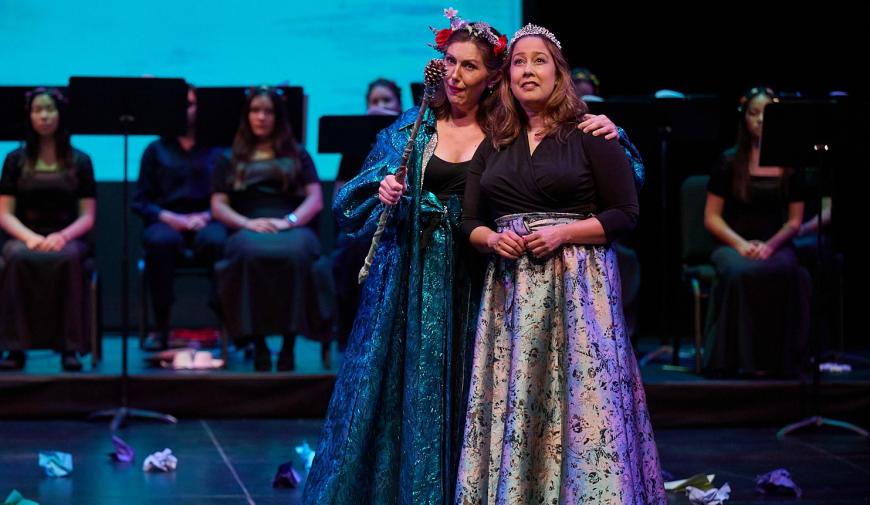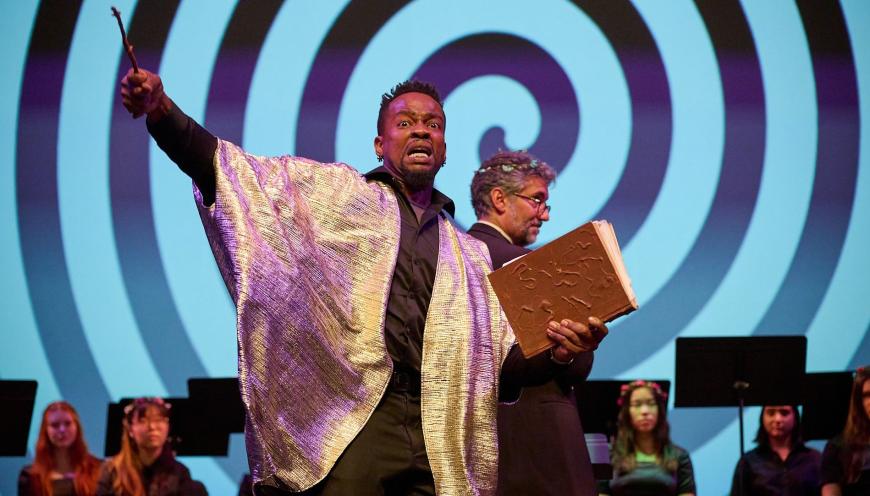
The Last Sorcerer is an opera small enough to be performed in a living room. Scored for piano, solo voices, and treble choir, composer Pauline García Viardot created the work for the salon — not the opera house — and it premiered at librettist Ivan Turgenev’s villa in 1867. Viardot’s children and vocal students sang the roles, while she accompanied them on the piano. The audience, which included the likes of Franz Liszt, Johannes Brahms, and Clara Schumann, hailed the opera as a treasure.
After her death, Viardot’s original manuscript was locked away in a private collection for nearly 150 years.
Friday night’s Sing for Hope production of The Last Sorcerer (presented by the Wallis Annenberg Center for the Performing Arts) marked the triumphant, belated world premiere of Viardot’s original setting of the opera.
Sing for Hope, The Wallis’s current company-in-residence, was co-founded by Camille Zamora and Monica Yunus, who both sang leading soprano roles in the show. Zamora, in particular, has been instrumental in the revival of Viardot’s opera; she wrote the English-language narration (performed by an engaging Monique Coleman) and spearheaded a studio recording of the work in 2019. She also co-directed this production, along with Sharyn Pirtle.

Nearly every aria in this opera is a banger. Viardot — herself a notable soprano and prolific composer of art songs — had a knack for finding the tune within a text.
The Last Sorcerer revolves around Krakamiche, a washed-up sorcerer who has grown impotent in his old age. In his youth, he invaded the forest to build his palace, disturbing the habitat of the native fairies, who now pester him to leave. He makes desperate attempts to respark his magic (succumbing to a magical-herb scam at one point), to no avail. He feels that he needs his powers to provide a lavish future for his daughter Stella, but all Stella wants is to live a modest life together with her love, Prince Lelio. With the help of some behind-the-scenes fairy machinations, Krakamiche is finally convinced to leave the forest and move on to the next chapter of his life with Stella and Lelio. The young lovers get married, and the forest returns to its natural state.
Singing the title role was the unflappable baritone Babatunde Akinboboye, whose expressions of greedy hope and disappointment lent a sobering relatability to Krakamiche. (Many in the audience belly-laughed when the aged sorcerer accidentally conjured a bee instead of a beast.) Akinboboye mostly sang from his “hut” in the orchestra pit — a perfectly logical staging choice, but it would have been nice to see the sorcerer on the proper stage more often.

Tenor Karim Sulayman had the audience in stitches as Perlimpinpin, the sorcerer’s valet and a former (now shrunken) giant. In an aria about his glory days, he deftly maneuvered his voice through various states of lucidity, invoking long pauses for “memory lapses,” singing some lines sweetly and honking on others. In a breathtaking moment, he purposely landed on a wrong note before exaggeratedly sliding into the correct one.
Pure-voiced soprano Anastasia Malliaras was consistently captivating as the mischievous elf Verlaine. Her vocal and physical agility made her part sound effortless.
Though she occasionally veered sharp, Yunus’s effusive voice and acting were well suited for the idealistic, heart-on-her-sleeve Stella. Zamora’s voice, warm and sweet, and intentional sense of movement gave her La Reine a compelling gravitas.
Soprano Julia Johnson impressively covered the mezzo-soprano trouser role of Prince Lelio on only 36 hours’ notice (Adriana Zabala was indisposed due to illness). Johnson, who understandably remained on book most of the show, delivered a winsome and vulnerable performance. Her voice in this role may not have projected as much as her counterparts, but her immaculate intonation and buoyant ornaments made up for it.
The forest fairies (treble choir) were a delightful ingredient of the production. Sung by flower-crowned members of the Los Angeles Children’s Chorus’s Chamber Singers (led by Fernando Malvar-Ruiz), they made clever use of handmade props and acted as a peanut gallery, giggling and pointing fingers at the ineffectual sorcerer. At the end of the night, the stage was littered with yellow, blue, lilac, and green paper airplanes.

The set was simple, effective, and charming. It featured production artwork by students from Savanna High School (Anaheim) and the Sing for Hope Lab (the Bronx, New York). The art, which varied in style and medium (crayon, pencil, digital art), was projected onto a large screen, serving as a rotating backdrop of forests, fireplaces, spell books, and more.
Holding the show together was Lucy Tucker Yates at the piano, who provided musical direction and tirelessly accompanied the singers for 70 minutes.
The exquisite costume pieces with strong silhouettes and bold colors were made by Suzanne Vinnik, who, in keeping with the “eco” theme of the opera, runs an ethical fashion label in L.A.
Sing for Hope’s impressive, environmentally conscious, community-involving presentation of The Last Sorcerer proved that you don’t need a fancy, bloated production to put on a fantastic show. Viardot’s opera holds its own against famous contemporaries, and companies would be remiss not to consider programming it in the future.



